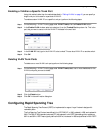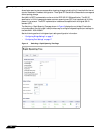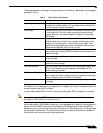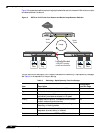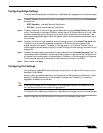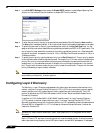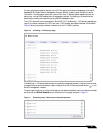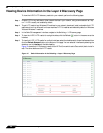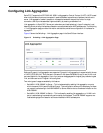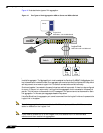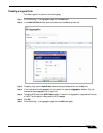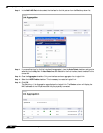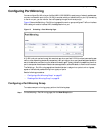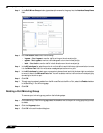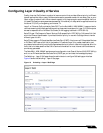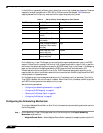
Configuring Switching
21
SonicOS 5.7: Advanced Switching Feature Guide and Screencast Tutorial
Configuring Link Aggregation
SonicOS 5.7 supports the IEEE 802.1AX-2008 Link Aggregation Control Protocol (LACP). LACP is used
when multiple network ports are connected in parallel between two switches or between a switch and a
server. Link aggregation makes it possible to increase the bandwidth beyond the limits of a single
connection, and to provide seamless, higher availability by creating a redundant link.
Link aggregation in SonicOS 5.7 allows port redundancy and load balancing in Layer 2 networks. Load
balancing is controlled by the hardware, based on source and destination MAC address pairs. The Switching
> Link Aggregation page provides information and statistics, and allows configuration of interfaces for
aggregation.
Figure 13 shows the Switching > Link Aggregation page in the SonicOS user interface.
Figure 13 Switching > Link Aggregation Page
Static and Dynamic Link Aggregation are supported. Dynamic Link Aggregation is supported with the use
of LACP (IEEE 802.1AX). Ports that are in the same VLAN (same PortShield Group) or are VLAN trunk
ports are eligible for link aggregation. Up to four ports can be aggregated in a logical group called a Logical
Link, and there can be four Logical Links configured.
Two main types of usage are enabled by this feature:
• SonicWALL NSA 2400MX to Server – This is implemented by enabling link aggregation on ports
within the same VLAN (same PortShield Group). This configuration allows port redundancy, but does
not support load balancing in the NSA 2400MX-to-Server direction due to a hardware limitation on the
NSA 2400MX.
• SonicWALL NSA 2400MX to Switch – This is allowed by enabling link aggregation on VLAN trunk
ports. Load balancing is automatically performed by the hardware. The NSA 2400MX supports one
load balancing algorithm based on source and destination MAC address pairs.



